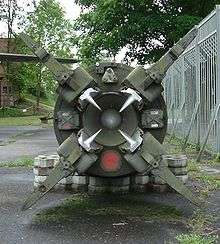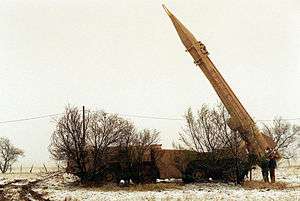R-17 Elbrus
| R-17 Elbrus | |
|---|---|
 An R-17 missile | |
| Type | Short-range ballistic missile |
| Place of origin | USSR |
| Service history | |
| In service | 1964- |
| Wars |
Iran-Iraq War, Yom Kippur War,[1] Soviet war in Afghanistan, Libyan Civil War, Gulf War |
| Production history | |
| Designer | Viktor Makeyev |
| Designed | 1956-1958 |
| Specifications | |
| Weight | 5,800 kg (12,800 lb) |
| Length | 11.2 m (37 ft) |
| Diameter | 0.88 m (2.9 ft) |
|
| |
| Propellant | UDMH/HNO3 |

The R-17 Elbrus,[2] GRAU index 9K72 is a tactical ballistic missile, initially developed by the Soviet Union. It is also known by its NATO reporting name SS-1C Scud-B. It is one of several Soviet missiles to carry the reporting name Scud; the most prolifically launched of the series, with a production run estimated at 7,000 (1960–1987). Also designated R-300 during the 1970s, the R-17 was derived from the R-11 Zemlya. It has been operated by 32 countries and manufactured in four countries outside the Soviet Union. It is still in service with some.
The first mock-up was designed and built by Makeyev in 1958–1959, before the programme was transferred to the Votkinsk Machine Building Plant in 1959 for mass production. The first launch was conducted in 1961, and it entered service in 1964.[3]
The R-17 featured important improvements over the R-11. The Isayev RD-21 engine used a combination of inhibited red fuming nitric acid (IRFNA) oxidiser and unsymmetrical dimethylhydrazine (UDMH) fuel, fed into the combustion chamber by fuel pumps that ensured a more consistent thrust. The guidance system, active only during the boosted phase, uses three gyroscopes, that give it a Circular Error of Probability (CEP) of 450m[4] (900m according to western sources.[5]) A nuclear warhead was designed for the R-17, with a selectable yield, from 5 to 70 kilotons. However it could also carry a chemical warhead, containing 555 kg of viscous VX; a conventional weapon, with a single high explosive warhead; or a series of fragmentation payloads, using either high explosive, anti-tank or anti-runway munitions.[4]
At first, the R-17 was carried on a tracked TEL similar to that of the R-11, designated 2P19, but this was not very successful, as the vibration of the tracks had a tendency to interfere with the launch electronics. Production of this model was halted after Khrushchev cancelled the production of heavy tanks in 1962, and a wheeled launcher was designed by the Titan Central Design Bureau, becoming operational in 1967.[6] The new MAZ-543 vehicle was officially designated 9P117 Uragan, and its Russian crews nicknamed it Kashalot (sperm whale), because of its size.[7] The eight-wheeled MAZ-543 has a loaded weight of 37,400 kg, a road speed of 55 km/h and a range of 650 km. It can carry out the launch sequence autonomously, but this is usually directed from a separate command vehicle. The missile is raised to a vertical position by means of hydraulically powered cranes, which usually takes four minutes, while the total sequence lasts about one hour.[4]
Combat use
Libya - It has been rumored that Scud-B's were fired by Gaddafi forces against rebels in the 2011 Libyan civil war during the first phase of the war.[8] On 14 August 2011 a confirmed Scud-B launch was detected by a US Aegis destroyer, with the missile fired from Sirte and heading toward rebel positions in Ajdabiya. The missile fell 80 km off target in the middle of the desert, inflicting no damage.[9] Eight days later, on August 22, three more Scud-B launches were detected by NATO.[10]
Specifications
- Range – 300 km,[1][11]
- CEP – 500–900 m[12]
- Type of fuel – liquid
- Preparation time – 1 hour
- Period of storage – 19 years (in stock), 6 month (in combat condition)
- Flight time – 15 minutes
See also
References
- 1 2 http://www.russianspaceweb.com/r17.html
- ↑ Johnston's Archive - SOVIET/RUSSIAN MISSILE DESIGNATIONS
- ↑ Wade, Mark. "R-17". Encyclopedia Astronautica. Retrieved 2008-02-13.
- 1 2 3 "SS-1 `Scud' (R-11/8K11, R-11FM (SS-N-1B) and R-17/8K14)". Jane's Information Group. 26 April 2001. Archived from the original on 2007-12-15. Retrieved 2008-02-12.
- ↑ "R-11/SS-1B SCUD-A R-300 9K72 Elbrus/SS-1C SCUD-B". Federation of American Scientists. September 9, 2000. Retrieved 2008-02-21.
- ↑ Zaloga, pp. 14–15
- ↑ Zaloga, p. 17
- ↑ Gilligan, Andrew (2011-05-08). "The forgotten frontline in Libya's civil war". The Daily Telegraph. London.
- ↑ McElroy, Damien (2011-08-16). "Gaddafi fires Scud missile at rebel forces". The Independent. Retrieved 19 September 2011.
- ↑ "NATO says Gaddafi forces fire three Scud-type rockets". Reuters. 2011-08-22.
- ↑ http://space.skyrocket.de/doc_sat/soviet_missiles.htm
- ↑ http://inbsite.com/missiles1.html
- 9К72 (Р-300) - Информационная система "Ракетная техника" (Russian)
- Ракетный комплекс 9К72 (Russian)
- 9К72 "Эльбрус" Scud-B ракетный комплекс - Военный Информатор. Основы военной доктрины (Russian)
- Оперативно-тактический ракетный комплекс 9К72 "Эльбрус" (Russian)
- 9К72 (Р-300) - 159 ракетная бригада ОТР (Russian)
- Военком - Оперативно-тактический ракетный комплекс 9К72 "Эльбрус" (Russian)
- Оперативно-тактический ракетный комплекс Р-17 (Russian)
- Ракета 8К14 (Р-17) (Russian)
- RusArmy.com - Ракетный комплекс 9К72 "Эльбрус" (Russian)
- 9K72 «Elbrus» tactical missile system (Russian)
